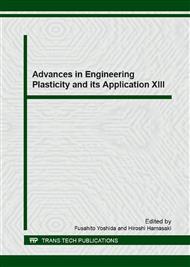p.116
p.122
p.127
p.132
p.138
p.143
p.149
p.156
p.162
Characterization of Hardening Behavior at Ultra-High Strain Rate, Large Strain, and High Temperature
Abstract:
This paper is concerned with the characterization of the OFHC copper flow stress at strain rates ranging from 10−3 s−1 to 106 s−1 considering the large strain and high temperature effects. Several uniaxial material tests with OFHC copper are performed at a wide range of strain rates from 10−3 s−1 to 103 s−1 by using a INSTRON 5583, a High Speed Material Testing Machine (HSMTM), and a tension split Hopkinson pressure bar. In order to consider the thermal softening effect, tensile tests at 25°C and 200°C are performed at strain rates of 10−3 s−1,101 s−1, and 102 s−1. A modified thermal softening model is considered for the accurate application of the thermal softening effect at high strain rates. The large strain behavior is challenged by using the swift power law model. The high strain rates behavior is fitted with the Lim–Huh model. The hardening curves are evaluated by comparing the final shape of the projectile from numerical simulation results with the Taylor impact tests.
Info:
Periodical:
Pages:
138-142
Citation:
Online since:
December 2016
Authors:
Keywords:
Price:
Сopyright:
© 2017 Trans Tech Publications Ltd. All Rights Reserved
Share:
Citation:


